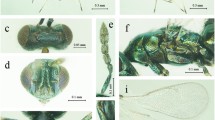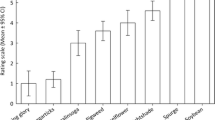Abstract
Brazilian peppertree (Schinus terebinthifolia Raddi, Anacardiaceae) is an aggressive invasive species that occurs in peninsular Florida, USA. Current management techniques are expensive, require repeated application, and cause non-target damage in ecologically sensitive habitats. Calophya lutea Burckhardt and Calophya terebinthifolii Burckhardt & Basset (Hemiptera: Calophyidae) were found damaging Brazilian peppertree in Brazil. To determine if C. lutea and C. terebinthifolii are suitable biological control agents of Brazilian peppertree, host specificity testing was conducted in a quarantine laboratory. In total, 97 plant species were tested, and oviposition and gall initiation were evaluated under no-choice conditions. Calophya lutea and C. terebinthifolii oviposited on nine and five of the 97 plant species tested, respectively. The majority of the eggs were laid on Brazilian peppertree and complete immature development with adult emergence occurred only on Brazilian peppertree. Adult longevity and behavior were determined in a separated experiment on all non-target species on which Calophya oviposited during the host specificity experiment. Adult longevity was four to five times longer on Brazilian peppertree when compared to non-target species. Based on our results, we conclude that both C. lutea and C. terebinthifolii are host-specific and form galls and complete development only on Brazilian peppertree. Therefore, these agents are considered safe to release in Florida and should be incorporated into the ongoing biological control program.

Similar content being viewed by others
References
Barkley FA (1944) Schinus L., Springer, New York
Bhattarai GP, Diaz R, Manrique V, Turechek WW, Buss L, Stange B, Overholt WA (2017) Diversity and impact of herbivorous insects on Brazilian peppertree in Florida prior to release of exotic biol control agents. Biocontrol Sci Technol 27:703–722
Burckhardt D, Basset Y (2000) The jumping plant-lice (Hemiptera, Psylloidea) associated with Schinus (Anacardiaceae): systematics, biogeography and host plant relationships. Journal of Natural History 34:57–155
Burckhardt D, de Queiroz DL (2012) Checklist and comments on the jumping plant-lice (Hemiptera: Psylloidea) from Brazil. Zootaxa 3571:26–48
Burckhardt D, Cuda JP, Diaz R, Overholt WA, Prade P, de Queiroz DL, Vitorino MD, Wheeler GS (2018) Taxonomy of Calophya (Hemiptera: Calophyidae) species associated with Schinus terebinthifolia (Anacardiaceae). Florida Entomologist 101:178–188
Center TD, Purcell MF, Pratt PD, Rayamajhi MB, Tipping PW, Wright SA, Dray FA Jr (2012) Biological control of Melaleuca quinquenerva: an Everglades invader. BioControl 57:151–165
Christ LR, Cuda JP, Overholt WA, Vitorino MD, Mukherjee A (2013) Biology, host preferences, and potential distribution of Calophya terebinthifolii (Hemiptera: Calophyidae), a candidate for biology control of Brazilian peppertree, Schinus terebinthifolia, in Florida. Florida Entomologist 96:137–147
Cuda JP, Ferriter AP, Manrique V, Medal JC (2006) Interagency Brazilian peppertree (Schinus terebinthifolius) management plan for Florida. Florida Exotic Plant Pest Council, Gainesville, Florida, USA
Cuda JP, Enloe SF, Gioeli KT, Minteer CR, Prade P (2019) Brazilian peppertree: integrated management guide 2019. Florida Exotic Plant Pest Council, Gainesville, Florida, USA
Dawkins K, Esiobu N (2016) Emerging insights on Brazilian pepper tree (Schinus terebinthifolius) invasion: the potential role of soil microorganisms. Frontiers in Plant Science 7:712
Diaz R, Moscoso D, Manrique V, Williams D, Overholt WA (2014) Native range density, host utilisation and life history of Calophya latiforceps (Hemiptera: Calophyidae): an herbivore of Brazilian peppertree (Schinus terebinthifolia). Biocontrol Sci Tech 24:536–553
Diaz R, Manrique V, Munyaneza JE, Sengoda VG, Adkins S, Hendricks K, Roberts PR, Overholt WA (2015) Host specificity testing and examination for plant pathogens reveals that the gall-inducing psyllid Calophya latiforceps is safe to release for biological control of Brazilian peppertree. Entomol Exp Appl 154:1–14
Doren RF, Jones DT (1997) Management in Everglades National Park. In Simberloff D, Schmitz DC, Brown TC (eds.), Strangers in paradise: impact and management of nonindigenous species in Florida. Island Press, Washington D.C., USA, , pp. 275–286.
(EDDMaps) Early Detection and Distribution Mapping System (2020) Distribution maps. The University of Georgia—Center for Invasive Species and Ecosystem Health. Available online: https://www.eddmaps.org/. Accessed 12 January 2020.
Ewel JJ, Ojima DS, Karl DA, DeBusk WF (1982) Schinus in successional ecosystems of Everglades National Park. National Park Service - South Florida Research Center, Homestead, Florida, USA.
Feuereisen MM, Zimmermann BF, Schulze-Kaysers N, Schieber A (2017) Differentiation of Brazilian peppertree (Schinus terebinthifolius Raddi) and Peruvian peppertree (Schinus molle L.) fruits by UHPLC-UV-MS analysis of their anthocyanin and biflavonoid profiles. Journal of Agricultural Food Chemistry 5:5330–5338
(FLEPPC) Florida Exotic Pest Plant Council (2019) Florida Exotic Pest Plant Council’s 2019 List of invasive plant species. Available online: https://bugwoodcloud.org/CDN/fleppc/plantlists/2019/2019_Plant_List_ABSOLUTE_FINAL.pdf Accessed 28 April 2020.
Harris P, Shorthouse JD (1996) Effectiveness of gall inducers in weed biological control. Can Entomol 128:1021–1055
Havens K, Jolls CL, Knight TM, Vitt P (2019) Risks and rewards: assessing the effectiveness and safety of classical invasive plant biocontrol by arthropods. BioScience 69:247–258
Heard T (1997) Host range testing of insects. In: Julien M, White G (eds) Biological control of weeds: theory and practical application. Australian Center for International Agricultural Research, Canberra, Australia, pp 77–82
Hight SD, Cuda JP, Medal JC (2002) Brazilian peeppertree. In van Driesche R, Blossey B, Hoddle H, Lyon S, Reardon R (Eds.), Biological control of invasive plants in the Eastern United States. Morgantown, WV: USDA Forest Service Publication FHTET-2002–04, pp 311–321
Hinz HL, Schwarzlander M, Gassmann A, Bourchier RS (2014) Successes we may not have had: a retrospective analysis of selected weed biological control agents in the United States. Invasive Plant Science and Management 7:565–579
Hodkinson ID (2009) Life cycle variation and adaptation in jumping plant lice (Insecta: Hemiptera: Psylloidea): a global synthesis. Journal of Natural History 43:65–179
Lake EC, Minteer CR (2018) A review of the integration of classical biological control with other techniques to manage invasive weeds in natural areas and rangelands. BioControl 63:71–86
Manrique V, Cuda JP, Overholt WA (2013) Brazilian peppertree: a poster child for invasive plants in Florida. Journal of Florida Studies 1:1–14
Manrique V, Diaz R, Erazo L, Reddi N, Wheeler GS, Williams D, Overholt WA (2014) Comparison of two populations of Pseudophilothrips ichini (Thysanoptera: Phlaeothripidae) as candidates for biological control of the invasive weed Schinus terebinthifolia (Sapindales: Anacardiaceae). Biocontrol Sci Tech 24:518–535
Morton JF (1978) Brazilian pepper: It’s impact on people, animals and the environment. Econ Bot 32:353–359
Nickerson K, Flory SL (2015) Competitive and allelopathic effects of the invasive shrub Schinus terebinthifolius (Brazilian peppertree). Biol Invasions 17:555–564
Overholt WA, Diaz R, Rosskopf E, Green SJ, Overholt WA (2015) Deep characterization of the microbiomes of Calophya spp (Hemiptera: Calophyidae) gall-inducing psyllids reveals the absence of plant pathogenic bacteria and three dominant endosymbionts. PLoS ONE 10(7):e0132248
Pemberton RW (2000) Predictable risk to native plants in weed biological control. Oecologia 125:489–494
Prade P, Diaz R, Vitorino MD, Cuda JP, Kumar P, Gruber B, Overholt WA (2016) Galls induced by Calophya latiforceps (Hemiptera: Calophyidae) reduce leaf performance and growth of Brazilian peppertree. Biocontrol Sci Tech 26:23–34
Raman A (2011) Morphogenesis of insect-induced plant galls: facts and questions. Flora 206:517–533
Robertson MP, Kriticos DJ, Zacharlades C (2008) Climate matching techniques to narrow the search for biological control agents. Biol Control 46:442–452
Schaffner U (2001) Host range testing of insects for biol weed control: how can it be better interpreted? BioScience 51:951–959
Shorthouse JD, Wool D, Raman A (2005) Gall-inducing insects: nature’s most sophisticated herbivores. Basic Appl Ecol 6:407–411
Schmitz DC, Simberloff D, Hofstetter RH, Haller W, Sutton D (1997) The ecological impact of nonindigenous plants. In: Simberloff D, Schmitz DC, Brown TC (eds) Strangers in paradise: impact and management of nonindigenous species in Florida. Island Press, Washington, USA, pp 39–61
Stiling P (1993) Why do natural enemies fail in classical biological control programs? Am Entomol 39:31–37
Treadwell LW, Cuda JP (2007) Effects of defoliation on growth and reproduction of Brazilian peppertree (Schinus terebinthifolius). Weed Sci 55:137–142
Vitorino MD, Christ LR, Barbieri G, Cuda JP, Medal JC (2011) Calophya terebinthifolii (Hemiptera: Calophyidae), a candidate for biological control of Schinus terebinthifolius (Sapindales: Anacardiaceae): feeding preferences and impact studies. Florida Entomologist 94:694–695
Wapshere AJ (1974) Strategy for evaluating safety of organisms for biological weed control. Annals of Applied Biology 77:201–211
Wheeler GS, Silverson N, Dyer K, McKay F (2016) Brazilian collections and laboratory biology of the thrips Pseudophilothrips ichini (Thysanoptera: Phlaeothripidae): a potential biological control agent of the invasive weed Brazilian peppertree (Sapindales: Anacardiaceae). Florida Entomologist 99:6–11
Wheeler GS, Madeira PT (2017) Phylogeny within the Anacardiaceae predicts host range of potential biological control agents of Brazilian peppertree. Biol Control 108:22–29
Wheeler GS, Manrique V, Overholt WA, McKay F, Dyer K (2017) Quarantine host range testing of Pseudophilothrips ichini, a potential potential biological agent of Brazilian peppertree, Schinus terebinthifolia, in North America and Hawaii. Entomol Exp Appl 162:204–217
Williams DA, Overholt WA, Cuda JP, Hughes CR (2005) Chloroplast and microsatellite DNA diversities reveal the introduction history of Brazilian peppertree (Schinus terebinthifolius) in Florida. Mol Ecol 14:3643–3656
Acknowledgments
This project was supported in part by the Invasive Plants Section of the Florida Fish and Wildlife Conservation Commission, the Florida Department of Agriculture and Consumer Services, and the Florida Industrial and Phosphate Research Institute. We thank A. Mitchel, C.W. Miller, E.P. Demard, E.N.Y. Weeks, L. Calise, N.F.P. Macan, and R. Diaz for helping with manuscript edits and/or plant care and acquisition.
Author information
Authors and Affiliations
Corresponding author
Ethics declarations
Conflict of interest
All authors state that there are no conflict of interest to declare.
Ethical approval
The Calophya spp. used in this study were obtained from colonies maintained at the Hayslip Biological Control Research and Containment Laboratory, Indian River Research and Education Center, University of Florida, Fort Pierce, FL, USA. Calophya spp. were collected and exported from Brazil under the permit 12BR008156/DF from the Ministry of Environmental Resources of Brazil and imported into the USA under the permit USDA/APHIS/PPQ P562P-12–00304.
Additional information
Handling Editor: S. Raghu.
Rights and permissions
About this article
Cite this article
Prade, P., Minteer, C.R., Gezan, S.A. et al. Host specificity and non-target longevity of Calophya lutea and Calophya terebinthifolii, two potential biological control agents of Brazilian peppertree in Florida, USA. BioControl 66, 281–294 (2021). https://doi.org/10.1007/s10526-020-10058-3
Received:
Accepted:
Published:
Issue Date:
DOI: https://doi.org/10.1007/s10526-020-10058-3




